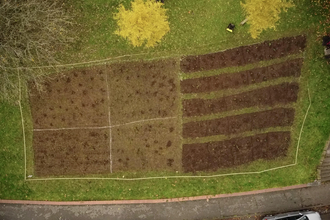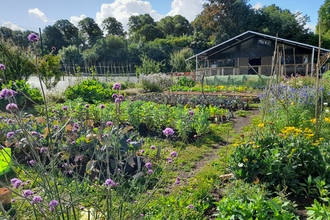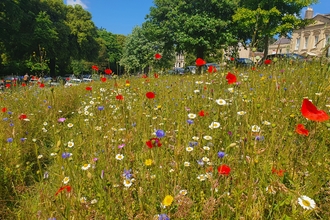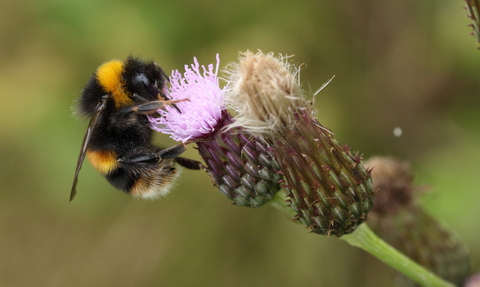
Buff-tailed bumblebee © Vaughn Matthews
Pollinators Resource
Become a force for nature
Bees are amazing pollinators, so are moths, butterflies, flies and beetles. There are many easy things we can all do to help these creatures, who not only pollinate our food crops (every third bite in fact!) but they also ensure the survival of wildflowers, which supports other wildlife species. All actions together make a big difference to help bring back nature locally.
Good to know: pollinators eat nectar and collect pollen, which is transferred to other plants. Some pollinators also eat pollen.
Case studies featured on this page received funding from the West of England Combined Authority community pollinator fund.
The groups share their experience and advice about wildlife-friendly practices to benefit not only pollinators, but the wider natural habitats, species and local people. They show how local people improved their neighbourhoods, aligned with the Nature Recovery Network and provided opportunities to get involved with nature to improve health and wellbeing.
Below are five ways to do your bit for pollinators:
Manor Woods Valley Group
1. Mini-meadow magic
Manor Woods Valley Local Nature Reserve have three amazing wildflower meadows. It's possible to plant your own wildflowers and even transform part of your lawn into a mini-meadow, bringing beauty, colour and pollinators to the space.
- Plant a variety of wildflowers, such as field scabious, common knapweed and oxeye daisy. Plus devil's bit scabious or hemp agrimony for late flowering plants.
- Convert part of your lawn into a mini-meadow. It's easy to do and maintain - see below.
- If everyone on your street did this - there'd be an amazing green corridor.
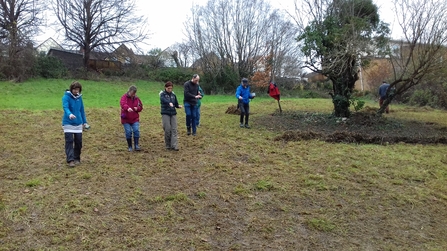
Manor Woods Valley Group
Manor Woods Valley Local Nature Reserve is an ideal place to learn about wildlife and habitats through hands-on experience. Volunteers sessions and local schools regularly get involved with the site and have helped to plant wildflower bulbs and ongoing management. These bulbs mostly benefit early-season pollinating insects, such as emerging bees, butterflies, moths, lacewings and hoverflies, as well as the botanical and general biodiversity of the site.

Stephanie Chadwick
2. Get wilder!
By letting parts of your garden or green space go a little wild, new habitats are created.
- Long grasses and wild areas improve conditions for insects as it provides them with shelter and breeding space. This in turn provides food for birds, butterflies, moths and mammals such as hedgehogs.
- Nettles are great for butterflies, as well as being nitrogen rich which improves the soil.
- Dead hedges create amazing habitats for insects, plus they use materials from the site to create natural barriers.
Community Orchards are prime examples of creating this kind of habitat space and providing a beautiful space to benefit people and wildlife.
Community Orchards bring the community together, a place for social and nature connections and many opportunities to learn about linking habitats together. Corston Orchard are a prime example of working with nature and the local community, learning together about creating habitat spaces.
Thornbury Community Orchard Group have a bee bank and many bee hotels (holes in wood) for the bee's to live in, an orchard where the bee's work and a wildflower meadow where they eat. Plus many more wildlife friendly practices, such as dead hedges, wild patches and birdboxes.
Vaughn Matthews
3. Night scented gardens
Moths are important pollinators. You can plant night-scented, white/light flowers that 'glow' in the moon light to attract and support moths. Generally speaking, growing a variety of flowers will help pollinators.
- Redcatch Community Garden have planted: jasmine, evening primrose, honeysuckle, night-scented flocks, bladder campion and white campion.
- Caterpillars (of moths) feed on plants such as common hawthorn, ivy and fuchsia and overwinter in dead plant matter.
Redcatch Community Garden have created their 'moon garden' for night-time pollinators, as well as developing nature trails to inspire, demonstrate and give advice about what people can do for nature at home, linking this activity together to create green corridors. We love Lou, Head Gardener in the video above!

(c) Guy Manchester
4. Community power
The Wellspring settlement in Barton Hill is an oasis of pollinator friendly gardens and community spirit. The community got together to share their ideas, resources, knowledge and aspirations for the local area. Community led actions are what local people are already doing to improve their neighbourhoods. This can include litter picks and turning unloved areas into beautiful natural areas, looked after locally.
- Look for local community groups that already exist on the Team Wilder Community map.
- Check out the resources below to create a group if there's a gap!
- A litter pick is a good place to start.
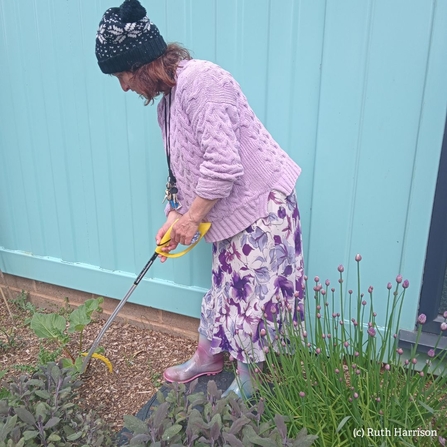
Ruth Harrison
Sarah from Barton Hill had gotten frustrated about the amount of litter everywhere, so she decided to make a difference by litter picking. There are free resources available for litter picking on this Team Wilder litter picking resource. What would improve your neighbourhood for people and wildlife?

Sophie Bancroft
5. Too cool for school
Linking activities at schools with community actions for nature will always benefit people and wildlife. The Winterbourne and Frome Valley Environmental Group have made many local connections with individuals, organisations and schools to link up pollinator pathways, upskill the community and inspire local connected actions for nature.
- Improve school grounds for wildlife - free pack.
- Get free professional advice for schools, community spaces or gardens from the Team Wilder Community Ecologist.
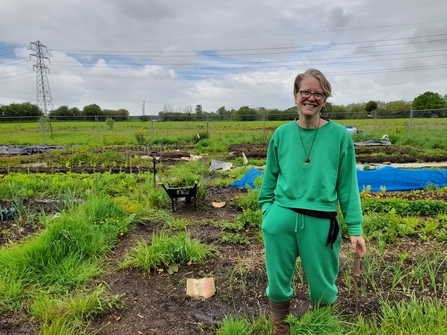
Sophie Bancroft
Kate from the Frome Valley Growing Project has supported local schools to enhance their pollinator habitats on the school grounds using permaculture principles. This included advice from the Team Wilder Community Ecologist about surveying the schools, identifying existing biodiversity and future plans. And also provide 24 Eco School sessions at the three primary schools, over 3 months. This not only engages children in nature, but also teaches them how to improve their own gardens for wildlife by planting native wildflowers, never using chemicals and creating habitats such as log piles and bug hotels.
Put your action on the map
We'd love to hear what you're doing to help pollinators and other species at home, in the community, at school or work.
Making small changes to your everyday life can make a huge difference to you and local wildlife. By making changes to our gardens, patios and window boxes, we're making a big difference collectively. This map shows the collective effort of Team Wilder so far. Share what you have done to inspire others.
This includes making a chemical free pledge. You can also click on the map icons below, to see what other people have been doing.




